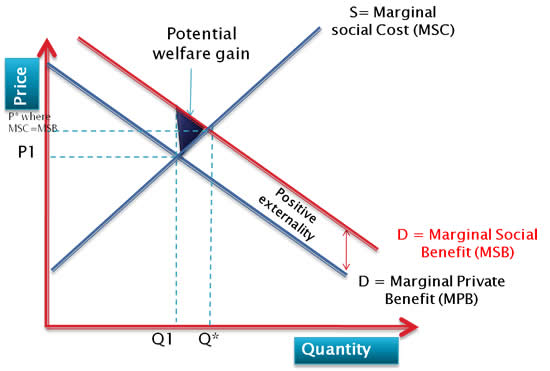Demerit Goods
Demerit goods are goods which are deemed to be socially undesirable, and which are likely to be over-produced and over-consumed through the market mechanism. Examples of demerit goods are cigarettes, alcohol and all other addictive drugs such as heroine and cocaine.
The consumption of demerit goods imposes considerable negative externalities on society as a whole, such that the private costs incurred by the individual consumer are less than the social costs experienced by society in general; for example, cigarette smokers not only damage their own health, but also impose a cost on society in terms of those who involuntarily passively smoke and the additional cost to the National Health Service in dealing with smoking-related diseases. Thus, the price that consumers pay for a packet of cigarettes is not related to the social costs to which they give rise i.e. the marginal social cost will exceed the market price and overproduction and over-consumption will occur, causing amisallocation of society’s scarce resources. This is illustrated in figure below.

In negative consumption externality, the MPB is not reflecting social benefit and thus MSB lies below MPB. The vertical difference between MPB and MSB is the negative externality. The optimal level of consumption is where MSB=MSC i.e. Q*. However the negative externality is being ignored and thus there is an over consumption of the goods at Q1.
Merit Goods
Merit goods generate substantial positive externalities
Merit goods confer benefits on society in excess of the benefits conferred on individual consumers; in other words, there is a divergence between private and social costs and benefits, as the social benefits accruing to society as a whole from the consumption of such goods tend to be greater than the private benefits to the individual. This divergence means that the private market cannot be relied upon to ensure an efficient allocation of society’s scarce resources. The problem is that individual consumers and producers make their decisions on the basis of their own, internal costs and benefits, but, from the standpoint of the welfare of society at large, externalities must be considered. This point can be illustrated in relation to health care and education:
Health care generates a number of positive externalities; for example, if all people receive adequate levels of healthcare, the nation’s workforce is likely to be fitter and healthier, less working days would be lost through sickness, and this would have beneficial effects on the level of output and economic growth; vaccinations and preventative health care which prevent the spread of contagious diseases such as small-pox and whooping cough, clearly not only benefit the individuals receiving the treatment, but also the rest of society at large. Indeed, a major reason for the relatively weak economic performance of many of the poorer countries of the world is the widespread incidence of ill-health and disease amongst their populations.
Similarly, in the case of education, there are a number of positive externalities from which society at large may benefit, which may not directly accrue to the individual pupil/student. Individuals clearly derive private benefits from higher levels of education as, for example, earning capacity is to a considerable extent a function of educational attainment. However, society at large receives the benefits of a more highly skilled, adaptable and thus more efficient workforce, which is one of the key ingredients of economic success.
The important point then is that if people had to pay privately through the market for such merit goods as health and education they would consider only their private benefits and their private costs and would thus consume too little from the point of view of the best interests of society as a whole. This problem of under-consumption is illustrated in Figure below.

As the diagram illustrates, the MSB lies above the MPB and the difference between the two consists of positive externality. The socially optimal level is where MSB=MSC i.e Q*, however, due to under-allocation of resources the output/consumption is at Q1.





